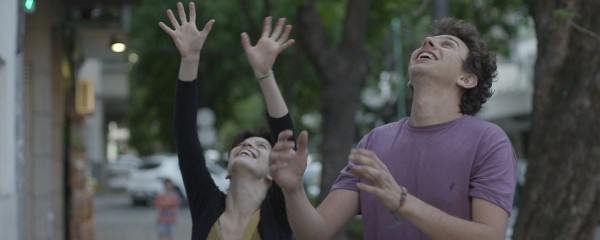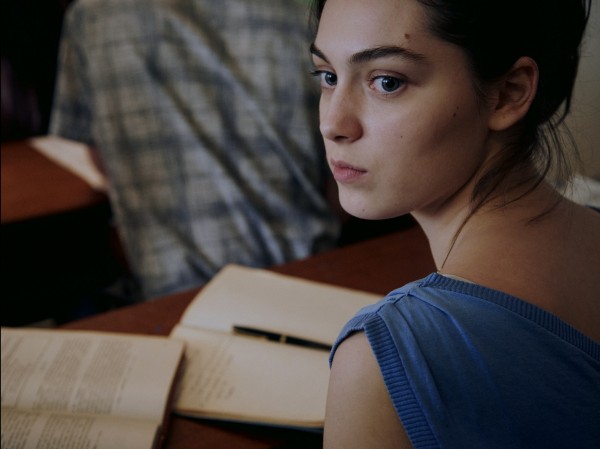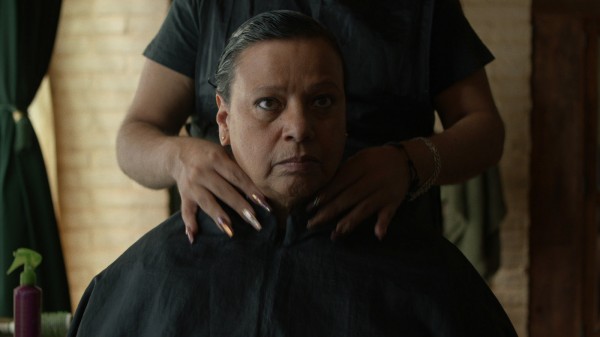-
NEW DIRECTORS/NEW FILMS 2022 (April 20-May 1, 2022)
Last edited by Chris Knipp; 03-10-2023 at 11:16 PM.
-
ALBUM FOR THE YOUTH (Malena Solarz 2021)
MALENA SOLARZ: ALBUM FOR THE YOUTH/ÁLBUM PARA LA JUVENTUD (2021)

SANTIAGO CANEPARI (RIGHT) IN ALBUM FOR THE YOUTH
Argentine university students followed around in innocuous vérité scenes
Malena Solarz's film is sweet, natural, and flowing. It's also blah. The written passages are uninteresting and the piano playing is a bit out of tune. These late-teens are well-behaved. They rarely smoke, they do not drink too much, they are polite. I kept wishing the same figures had different dialogue - that led somewhere. Instead they're just talking about studying and exams, parents and vacations. Relationships are not developed, or are too neutral to be interesting. A critique in Spanish on Escribiendocine said: "Álbum para la juventud (2021) has two young people, Pedro (Santiago Canepari) and Sol (Ariel Rausch), wandering the streets in their routines, in their 'white people problems,' which in reality are not many but for them are important . . . More navel-gazing than promoting a generational fresco, the film allows Solarz to propose an ideal universe in which, precisely this idealization, makes it impossible to project empathy with these anodyne characters."
Variety:
Achieving a rare double this year – selection for both the Mar del Plata Festival and Ventana Sur’s pix-in-post competitions – Malena Solarz’s “Album for the Youth” marks the first solo feature of a director who tackles one of the most common of debut themes – a coming of age tale – but begs to differ on its structure.
Coming-of-age features “usually have big dramatic arcs as the characters discover something very important about their identity, their sexuality, etc. Here the characters do not have big revelations. I was mainly interested in working on a much smaller, millimetric scale almost,” Solarz explained to Variety.
So “Album for the Youth” gently charts the halting and initial maturing of two teens who both could have a first relationship and show creative yearnings – Sol (Irina Rausch) in music and Pedro as a writer (Santiago Canepari) – which may feed into careers later in life.
Both plots weave, “looking for themselves” the director said, adding: “They are curious about some things and so is the movie- There’s some clumsiness in their bodies and gestures, and in the movie as well.”
Solarz cites as inspiration France’s Éric Rohmer and Maurice Pialat and U.S. contemporary comedies. Working with DP Fernando Lockett (Fernando Guerrero’s 'The Dark Beast'), she tried to maintain a certain distance from characters. 'I didn’t want to translate their feelings into cinematic elements – colors, camera movements. I like the idea of the story being watched through a barely visible formal filter,' she added.
That can also be seen as just not going to much bother.
Album for the Youth/Álbum para la juventud , 80 mins., debuted at Mar del Plata Nov. 2021; also shown at New Directors/New Films (FLC, MoMA) in April 2022, screened there for this review.
Last edited by Chris Knipp; 04-14-2022 at 08:03 PM.
-
CHILDREN OF THE MIST (Diễm Hŕ Lệ 2021)
DIEM HA LE: CHILDREN OF THE MIST (2021)

[Woman] filmmaker helplessly follows a cruel Hmong custom: child bride kidnapping
Diễm Hŕ Lệ's participating-observer documentary is a plunge into ethnography and the world of the Hmong people of a mountainous and misty region of Northern Vietnam. No question about the skillful, artistically effective quality of this film. It begins with a glimpse of Diễm's pre-teen friend Di and then several beautiful panoramic shots of the local landscape, which could be described as both "rugged" and "delicate." The film meanders a bit, thus conveying families, personalities, and lifestyles. Gradually it acquires a very coherent form and a main subject, the lingering custom of "kidnapping" young girls and making them child brides,, robbing them of a childhood and a better future.
I thought of Lévy-Strauss's famous title Tristes Tropiques. Not that we are in the tropics. The cool climate occasions the wearing of highly embellished needlework known as paj ntaub or flower cloth: both men and women, especially for an important event, wear beautiful clothing and plenty of it. But observation of the Hmong arouses the mixture of feelings reflected in Lévy-Strauss' adjective "tristes" even though the Mmong are often smiling, laughing, and playful. They are "tristes" because frankly their lives are nothing to envy, a world of limitations, narrow horizons.
These lives are an odd mixture of hard physical work and almost continual play. Alcohol is central to their culture. A marriage agreement as well as an agreement to suspend an engagement are both sealed by a drink. But beyond that adult men often have a continual buzz on. Nor is drinking and drunkenness a restricted male activity, but practiced by women as well. With this seems to go confused and irresponsible behavior.
The custom of "kidnapping" underage brides is one of these. At the traditional time of the Lunar New Year festivities a boy goes off with Di on a sort of "date," and the next thing we know she has failed to return home. Both Di's parents and Di herself behave ambivalently about this. Though Di initially went along with things, she later acknowledges being mistaken because she doesn't like the boy (though other girls say he's good looking). Her parents keep contradicting themselves, sometimes agreeing to the kidmap-marriage, other times objecting to it. As the Variety review points out, at this point any resolve against marriage may now be too late "in a prickly period of negotiation between two mutually wary households, as matters of dowry, obligation and family honor are all considered ahead of the happiness of the two children in question." At one point Di's mother objects to her marrying Kang, the young boy, but then giggles and says "Is he rich?"
The kids go to school (a fairly new thing) and Diễm films in a classroom where we learn students regularly play hookey to help with farming chores. The teacher scolds them for this one by one. Later a group of teachers intervene on Di's behalf against the imposition of child marriage. But then can only opine, and then they withdraw, having no final authority over custom or family. Di recognizes that if she quits school to be a bride at fourteen, she is opting out of a better life, a possible job, and a chance (she says) to take her mother to places she has never seen beyond the village.
It is strange to observe that like everywhere in the world the Hmong, at least the young, carry cell phones so they are continually in touch with each other and, to some extent at least, the outside world. (Probably this aids them in learning Vietnamese as well as the Homng language, but that isn't gone into.) And they are on Facebook and have Facebook pages with all the speeded up electronic chatter and gossip that implies. Will this speed change? Surely one would think so, but it's too soon to say, and the culture is a powerful force for continuity in this isolated environment. (The town is only briefly glimpsed.)
The "participatory observer" role is a long-established one in ethnography, clearly true of Diễm, whom Di or others sometimes address. But it gets more intense when there's a scuffle and they bang into some of the film equipment, and finally when the kidnapping boy grabs Di to take her back and Diễm joins those trying to pull her back.
The adults are playful and childlike so three's a sense of fun. But we're left with a sense of hopelessness in the face of age-old customs that are disadvantageous for everyone, especially young women. These show no immediate signs of changing; but another film in a year or two may look different. Under the circumstances, we can't expect improvement.
Children of the Mist, 90 mins., debuted at Amsterdam Nov. 2021; also Seattle Apr. 2022; reviewed as part of New Directors/New Films (FLC, MoMA) Apr. 20-May 1, 2022.
Last edited by Chris Knipp; 04-14-2022 at 03:56 PM.
-
HAPPENING/L'ÉVÉNEMENT (Audrey Diwan 2021)
AUDREY DIWAN: HAPPENING/L'ÉVÉNEMENT (2021)

ANAMARIA VARTOLOMEI IN HAPPENING
A girl struggles with an unwanted pregnancy, 12 years before abortion was legalized in France
L'Événement, same title as Antonioni's classic but no relation, is a handsome, prettily lighted film in Academy ratio about a star university student who gets accidentally pregnant in 1963 France, twelve years before abortion became legal in France and four years before the advent of the Pill, and all she goes through to end the pregnancy and save her promising literary career. The film is notable for its unsparing detail about gynecological exams and procedures, in which the impressive, convincing star, Anamaria Vartolomei, is fearless, and for the clear way that contemporary attitudes are depicted. The character Vartolomei plays is called Anne Duchesne. The film is adapted from the eponymous autobiographical novel (Gallimard, 2000) by Annie Ernaux by the author, the director, and Marcia Romano. (Ernaux has published more than two dozen autobiographical novels, and won many awards.) Sadly, at a time when the right to abortion is being eroded in state after state and the likelihood of the Supreme Court's overruling the landmark 1973 Roe v Wade decision looms, this story is highly relevant in America. No film shows better why this matters.
Of course they're aiming at different things, but unlike Eliza Hittmann's tedious, dutiful Never Rarely Sometimes Always, or Crist ian Mungiu's relentless, flair-free 4 Months, 3 Weeks and 2 Days, Happening is a film that depicts what the pregnant girls's surrounding social situation is like.(I have not read the book, but it sounds like Ernaux is a great storyteller.)* We realize that in this world, for "respectable girls," Anne Duchesne's classmates, pre-marital sex is a thrilling fantasy but too dangerous to indulge in because accidental pregnancy is unthinkable. Anne has fallen into the unthinkable but she is tough enough to tackle it - on her own. Many are unsympathetic to her cause and most are afraid since anyone participating in abortion in France at this time is guilty of a crime and could go to jail. It is risky even to talk about it.
The French film is suspenseful, eventually intense and troubling, as Anne strives (not altogether successfully academically; her work deteriorates notably) to maintain a facade while she struggles to end her pregnancy by one means or another as the weeks, shown in on screen inter-titles, go by one after another. A self-inflicted method of injections and needles fails, partly because she learns doctors have tricked her with a prescription that strengthens the fetus, not weakens it. At "twelve weeks," Anne has gotten nowhere, but is at last headed for a back alley abortionist, more up a stairway. She is a slim, youthful woman with a deep voice. We see every moment of it from Anne's POV. There's no anesthetic, and she's ordered not to scream, which isn't easy. It's not an abortion; it's a procedure to cause a miscarriage.
It doesn't work. She goes back and has it done again, at great risk. This time it works but the process is nightmarish and painful and after help from her roommate Olivia (Louise Chevillotte), She has to be rushed to the hospital. Blessedly, for her, but doctor labels the event fausse couche - "a miscarriage." She's legal. Her life and her future have been saved, but only just.
In between the two procedures she has gone to her professor (Pio Marmaď) and begged him for the notes on his recent lectures so she can catch up and when asked if she has been sick replies, "a sickness that happens only to women and turns them into housewives." She tells him she no longe wants to teach but to become a writer. The film makes clear she went back for the dangerous second try because of her choice to risk death or imprisonment rather than give up her future.
Naturally, it didn't exactly happen like quite this, and things didn't look at the darkest moments like a yellow-tinged 17th-century painting as they do in dp Laurent Tangy's lovely square-framed cinematography. But Audrey Diwan has delivered a film that combines the harsh and shocking and the classic and beautiful in an original and remarkable way.
The film features Kacey Mottet Klein as Anne's friend Jean and Luŕna Bajrami and Louise Orry-Diquéro as her friends Hélčne and Brigitte, respectively.
Happening/L'Événement,100 mins., debuted at Venice Sept. 2021, winning the top prize, the Golden Lion for Best Film, and showed at two dozen other festivals in 2021 and 2022 including Chicago, Vienna, Miami, AFI, Rotterdam, Palm Spring, Sundance, ND/NF and SFIFF. At the Césars Anamaria Vartolomei won Most Promising Actress (Meilleur espoir féminin) and the film won Best Adaptation; nominations for Best Director and Best Film. It won Best Director at the BAFTA awards and numerous other awards and nominations at other festivals. The film opened theatrically in France Nov. 24, 2021, with an AlloCiné press rating of 4.1 (82%) based on 33 reviews. US release May 6, 2022.
______________
*The French Canadian film about a teenage girl who chooses to keep an unwanted pregnancy, Jean Leblanc's Les nôtres/Our Own (2021), also provides a rich surrounding social picture, but it's different because it doesn't lead to abortion.
Happening/l'Événement, 100 mins.., debuted at Venice Sept. 5, 2021, and showed in 27 other internationnal festivals including Vienna, Miami, AFI, Rotterdam, Sundance, Goteborg, and in Apr. 2022, New Directors/New Films and SFIFF. US theatrical release May 6, 2022.
Last edited by Chris Knipp; 04-22-2022 at 10:33 PM.
-
DOS ESTACIONES (Juan Pablo González 2022)
JUAN PABLO GONZÁLEZ: DOS ESTACIONES (2022)

MARIA GARCIA IN DOS ESTACIONES
In the bucolic hills of Mexico's Jalisco highlands, iron-willed businesswoman Maria Garcia fights the impending collapse of her tequila factory.
Dos Estaciones” centers on artisanal tequilera Maria Garcia (a towering Teresa Sánchez) as she fights to keep her family tequila business afloat amidst a plague damaging the agave crops and threats of a buyout from a greedy U.S. company.
The region’s seemingly endless light is beautifully photographed by cinematographer Gerardo Guerra, who captures the inside of Maria’s tequila plant as elegantly as he does the vast agave fields. We’re introduced to Maria with a long tracking shot, her broad shoulders filling the whole frame. She is a titan of industry here, not just supplying jobs in her factory, but supporting other businesses like her hairdresser Tatín (Tatín Vera, a non-professional actor playing a variation of themself).
Like Maria, Tatín is an artist and theirs is a relationship of mutual respect. However the balance of power shifts when Tatín declares they plan to expand their shop without Maria’s help. Sánchez plays this moment quietly, her eyes showing both hurt for not being needed further and also pride for Tatín’s success.
The mannered, deliberate pace of González’s filmmaking matches Maria’s dignified reverence for her craft. The ethereal choral music as she explains how tequila is made brings an almost mythical quality to the process. Sánchez imbues Maria, the last in a long line of true artisans, with such good humor despite her often stoic expressions that when she acts from desperation, you can’t help but root for her to succeed. - Marya E. Gates, RogerEbert.com.
Dos estaciones, 97 mins., debuted at Sundance Jan. 2022, also shown at Sun Valley Mar. 2022 and New Directors/New Films Apr. 2022.
Last edited by Chris Knipp; 04-19-2022 at 11:39 PM.
-
FIRE OF LOVE (Sara Dosa 2022)
SARA DOSA: FIRE OF LOVE (2022)

MAURICE AND KATIA KRAFFT IN FIRE OF LOVE
A French volcanologist couple who pursued their passion in tandem, gathered spectacular footage, came too close, and died together in their forties
Intrepid scientists and loving couple Katia and Maurice Krafft died in a volcanic explosion doing the very thing that brought them together: unraveling the mysteries of volcanoes by capturing the most explosive imagery ever recorded.
Katia was a geochemist, Maurice was a geologist. They died coming too close to a Japanese volcano, at Unzen, in 1991. Alsatians from Strasbourg, hey had met in the sixties and married in 1970. They said their love of volcanoes was born out of their disappointment with humanity. They left behind an exceptionally rich visual record of their explorations and adventures, which has been assembled here with narration (perhaps written? but three other wordsmiths are also named: Shane Boris, Erin Casper and Jocelyne Chaput) read in the hoarse, wispy voice of filmmaker Miranda July.
The film and the description start out trying too hard: zooms roaring in and out; needless split screens; phrases like "Understanding is love's other name.""The camera loves them, and they love their own cameras back." "Volcanoes must destroy to create. But must this unruly cycle take human life?"
The material requires no embroidery. The couple are impassioned romantic obsessives. They married and honeymooned on the volcanic island of Santorini. They decided not to have children. Maurice says, "I prefer an intense, short life to a monotonous, long one. A kamikaze existence in the beauty of volcanic things."
This is obviously a passion threatening to overwhelm caution and scientific impartiality. The surpassing power of this most awesome and fiery of natural phenomena causes them to shiver with excitement - and stay dangerously close and, when they survive, are emboldened. Maurice rejects volcano categorization when questioned on a TV show, saying they're best treated one by one, as individual and unique. But he does accept the identification of two important types: the red ones, where lava flows, which are "kind" (gentilles), and the gray ones, the "killers" (les vulcans tueurs), the explosive ones which are far more destructive and dangerous. Eventually he and Katia turned their focus on the latter.
Maurice tells the camera he has an ambition "to go down a lava flow in a canoe," and says it can be done in Hawaii. He's tried floating around in a bay of sulfuric acid with another geologist in a small rubber raft; his chemist wife knew the dangers and stayed on shore. (How were they filmed out there up so close?)
As the Kraffts turn riskier and crazier, Maurice sometimes seems to look plumper and dumpier, and Katia appears ever leaner and more ascetic. Actually both are athletes, pursuing an activity that is as strenuous as it is dangerous. Back home in Strasbourg, they edit their voluminous material. She writes books with her still photos; he gives lectures and media appearances with their films, and thus they finance their ventures. Stills and film show them in a large room packed with their voluminous files.
They have the sensation of missing too many volcanoes - and of perhaps having a gruesome occupation. They miss the highly destructive eruption of Mount St. Helens in May 1980 in the Pacific Northwest - and are furious - but they spend three months there documenting the ash and damage (not as scenic for us, the viewers as the earlier images of glowing red lava and glorious fireworks of sparks). Miranda July reminds us this eruption in Washington State had the force of 25,000 Hiroshima-style atomic bombs; worth looking into. Mount St. Helens led the Kraffts to focus from then on on gray volcanoes like it - which also include Vesuvius. They're disturbed by the November 1985 Ruiz, Colombia eruption that killed over 22,000 people.
From our point of view perhaps it's the gentler red volcanoes that are more striking visually, but the gray ones are more powerful and hence perhaps more worthy of the Kraffts' attention. And so they wound up at Unzen where an unexpected pyroclastic flow killed them and 41 other observers. So they were not the lonely risk-takers they sometimes had been. They died at 45 (he) and 49 (she), indicating their lifestyle was as dangerous as the boldest mountain climbers'. They helped establish the importance of volcanologists in warning the public of the danger of volcanoes, but prediction is difficult and getting governments to prepare is an uphill battle.
This is a beautiful and interesting documentary, marred by Miranda July's wispy voice. There is a reason why films are traditionally narrated by people with clear, resonant voices and training in acting or elocution. Some find July's voice dramatic, but I side with the reviewer for Screen Daily who says she "lends the picture a preciousness that can be cloying." The Wikipedia article about the couple provides arguably more balanced information on the Kraffts' achievements and importance and their recognition in the field. This film leaves somewhat the impression that they were outliers, and under-reports their importance and the respect they received from other volcanologists. Even the title seems a frantic, unnecessary gesture to personalize what is already very personal because this couple, though they remain opaque, were as unique as Maurice insisted their dangerous subjects were.
Reviewed by Ryan Lattanzio for IndieWire and in Variety.
Fire of Love, 93 mins., debuted at Sundance Jan. 20, 2022; IMDb lists 15 other, mostly documentary festivals, also including San Francisco and New Directors/New Films (Apr. 27). Oct. 2022: getting special iMax showings throughout the country, including Oct. 17 at AMC Metreon, San Francisco AT 7 PM followed by Q&A with director Dosa, coeditor Chaput, and moderated by Amanda McBaine and Jesse Moss.
Last edited by Chris Knipp; 10-10-2022 at 05:24 PM.
 Posting Permissions
Posting Permissions
- You may not post new threads
- You may not post replies
- You may not post attachments
- You may not edit your posts
-
Forum Rules





 Reply With Quote
Reply With Quote





Bookmarks